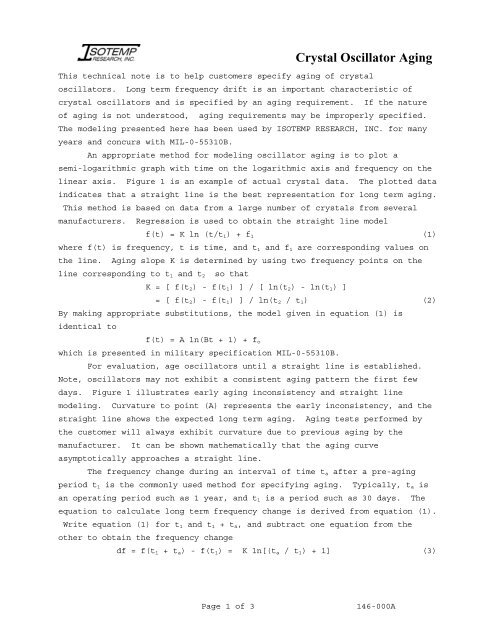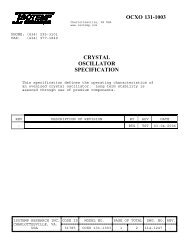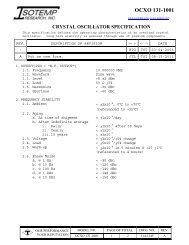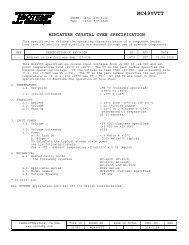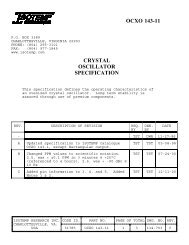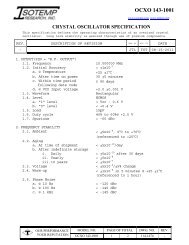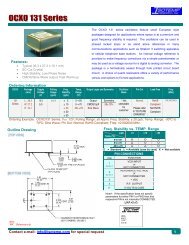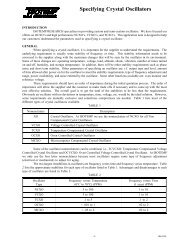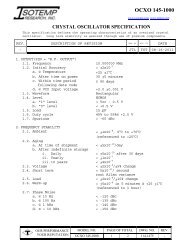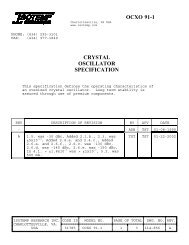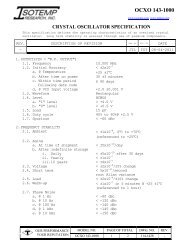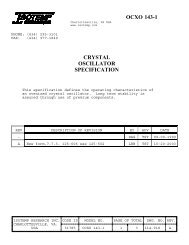Crystal Oscillator Aging - isotemp
Crystal Oscillator Aging - isotemp
Crystal Oscillator Aging - isotemp
You also want an ePaper? Increase the reach of your titles
YUMPU automatically turns print PDFs into web optimized ePapers that Google loves.
<strong>Crystal</strong> <strong>Oscillator</strong> <strong>Aging</strong><br />
This technical note is to help customers specify aging of crystal<br />
oscillators. Long term frequency drift is an important characteristic of<br />
crystal oscillators and is specified by an aging requirement. If the nature<br />
of aging is not understood, aging requirements may be improperly specified.<br />
The modeling presented here has been used by ISOTEMP RESEARCH, INC. for many<br />
years and concurs with MIL-0-55310B.<br />
An appropriate method for modeling oscillator aging is to plot a<br />
semi-logarithmic graph with time on the logarithmic axis and frequency on the<br />
linear axis. Figure 1 is an example of actual crystal data. The plotted data<br />
indicates that a straight line is the best representation for long term aging.<br />
This method is based on data from a large number of crystals from several<br />
manufacturers. Regression is used to obtain the straight line model<br />
f(t) = K ln (t/t1) + f1<br />
where f(t) is frequency, t is time, and t1 and f1 are corresponding values on<br />
the line. <strong>Aging</strong> slope K is determined by using two frequency points on the<br />
line corresponding to t1 and t2 so that<br />
K = [ f(t2) - f(t1) ] / [ ln(t2) - ln(t1) ]<br />
Page 1 of 3 146-000A<br />
(1)<br />
= [ f(t2) - f(t1) ] / ln(t2 / t1) (2)<br />
By making appropriate substitutions, the model given in equation (1) is<br />
identical to<br />
f(t) = A ln(Bt + 1) + fo<br />
which is presented in military specification MIL-0-55310B.<br />
For evaluation, age oscillators until a straight line is established.<br />
Note, oscillators may not exhibit a consistent aging pattern the first few<br />
days. Figure 1 illustrates early aging inconsistency and straight line<br />
modeling. Curvature to point (A) represents the early inconsistency, and the<br />
straight line shows the expected long term aging. <strong>Aging</strong> tests performed by<br />
the customer will always exhibit curvature due to previous aging by the<br />
manufacturer. It can be shown mathematically that the aging curve<br />
asymptotically approaches a straight line.<br />
The frequency change during an interval of time ta after a pre-aging<br />
period t1 is the commonly used method for specifying aging. Typically, ta is<br />
an operating period such as 1 year, and t1 is a period such as 30 days. The<br />
equation to calculate long term frequency change is derived from equation (1).<br />
Write equation (1) for t1 and t1 + ta, and subtract one equation from the<br />
other to obtain the frequency change<br />
df = f(t1 + ta) - f(t1) = K ln[(ta / t1) + 1] (3)
obtain<br />
<strong>Crystal</strong> <strong>Oscillator</strong> <strong>Aging</strong><br />
The daily aging rate may be obtained by differentiating equation (1) to<br />
df(t)/dt = K/t (4)<br />
This relationship allows calculation of a required daily aging rate any time<br />
based on an aging slope K.<br />
To apply these equations, refer to figure 1. Using data from the<br />
straight line at points (A) and (B) equation (2) yields<br />
K = [(-47E-8) - (-17E-8)] / [ln(100 / 20)]<br />
= -18.6E-8<br />
To calculate the aging during the first year after day 15 use equation (3) to<br />
obtain<br />
df / f = (-18.6E-8) ln(365 / 15 + 1)<br />
or for 10 years of aging<br />
= -60.2E-8<br />
df / f = (-18.6E-8) ln(3650/15 + 1)<br />
= -102E-8<br />
The daily aging rate at day 15 from equation (4) is<br />
df(t) / dt = (-18.6E-8) / 15<br />
= (-1.24E-8) / Day<br />
The required daily aging rate at the end of a given preaging period to<br />
meet an aging specification is shown in the following calculations. Suppose a<br />
total aging of 3 PPM is specified for 10 years after 30 days preaging. From<br />
equation (3)<br />
And from equation (4)<br />
on day 30.<br />
K = 3 / [ ln (3650 / 30 + 1) ]<br />
= 0.624 PPM<br />
df(t) / dt = 0.624 / 30<br />
= 0.0208 PPM / Day<br />
The first example demonstrates that a major portion of aging occurs<br />
early in the oscillator's life. Also, a good aging oscillator can have a<br />
relatively large daily aging rate early in its operation. ISOTEMP RESEARCH,<br />
INC. has many years of experience in making aging evaluations and would be<br />
pleased to help you in specifying crystal oscillator aging.<br />
Page 2 of 3 146-000A
<strong>Crystal</strong> <strong>Oscillator</strong> <strong>Aging</strong><br />
REFERENCES: MIL-O-55310B Military specification for crystal oscillators. U.S.<br />
government.<br />
For further information on the specification and application of Ovenized <strong>Crystal</strong> <strong>Oscillator</strong>s, please contact the<br />
sales or engineering staff at Isotemp Research, Inc. For reprints of this article, ask for document number 146-000.<br />
P.O. Box 3389<br />
Charlottesville, VA 22903 USA<br />
Voice: (804) 295-3101<br />
FAX: (804) 977-1849<br />
www.<strong>isotemp</strong>.com<br />
Isotemp Research Inc. is an American company building performance ovens and oscillators since 1968<br />
Page 3 of 3 146-000A


